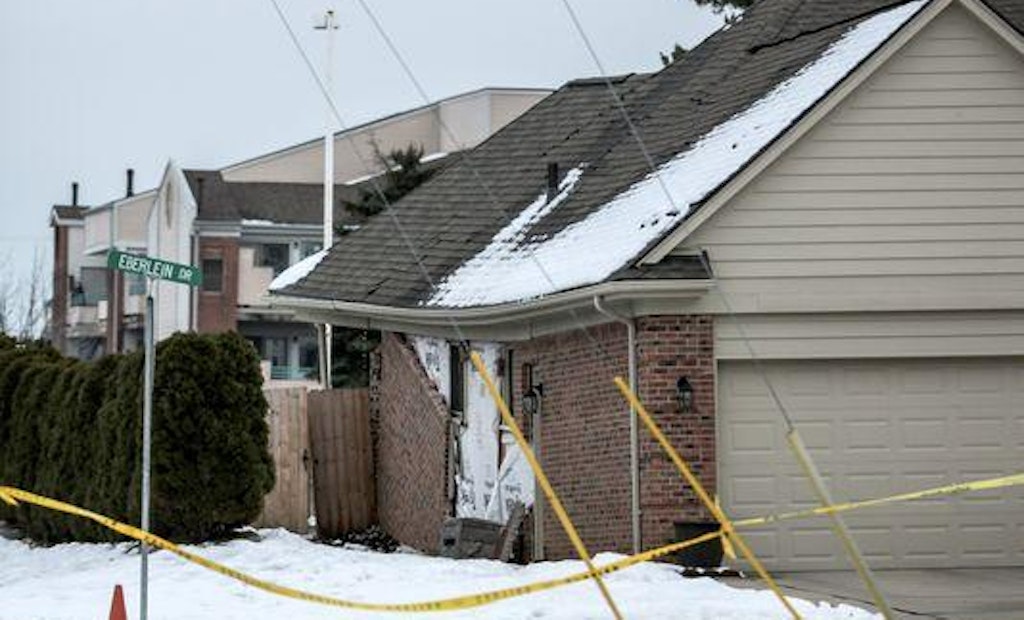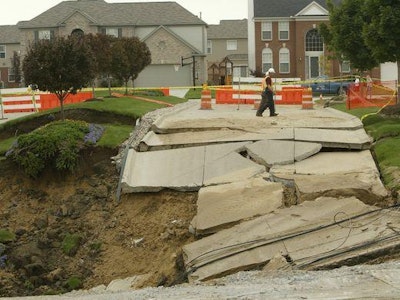
Interested in Infrastructure?
Get Infrastructure articles, news and videos right in your inbox! Sign up now.
Infrastructure + Get AlertsAn entire neighborhood in a Detroit suburb was evacuated over Christmas weekend after a massive sinkhole opened up, threatening to collapse a portion of the road and swallow at least three homes.
According to an article in the Detroit Free Press, officials suspect the cause is a leaky 11-foot-diameter sewer main 60 feet deep. The sinkhole, measuring 100 feet wide and 250 feet long, has displaced residents of 22 total homes in Fraser, Michigan. A portion of 15 Mile Road has been closed, and will likely remain so for months as repairs are made.
It’s not the first time that the sewer main — known as the 15 Mile Interceptor — has caused such a problem, according to the Detroit Free Press. Another sinkhole developed nearby in 2004, and the site of that sinkhole was the same location the pipe had collapsed in 1978, about six years after its initial construction. Another line, the Edison Corridor Interceptor, tying into the 15 Mile Interceptor also developed problems around that time.
According to John Shaw, a California-based forensic engineer and expert trial witness on sewer systems, “These kinds of catastrophic failures are generally improper maintenance or construction, engineering and design issues. To have one failure in a place certainly puts a utility on notice. To have two failures in one place really makes you wonder what happened.”
Is this simply the ramifications of aging pipes, which underscores the importance of investing in infrastructure? Or are other factors at play as well? The Detroit Free Press report provides some insight:
- After the Edison Corridor Interceptor failed in 1980, an engineering firm provided recommendations to the Detroit Water and Sewerage Department to prevent the same issues from occurring with the 15 Mile Interceptor, namely soil particles entering cracks in the pipe and eventually vacating the surrounding soil supporting the pipe, thus adding stress and worsening the pipe condition. Those recommendations called for annual inspections of the line until no changes were observed, then inspections at least every three years with grouting done to seal cracks and strengthen the surrounding soil. Records show Detroit Water and Sewerage did not grout or inspect the section of pipe that led to the 2004 sinkhole in the 10 years prior to the sinkhole.
- Contracts for repairs to the 15 Mile Interceptor following the 2004 sinkhole were part of the racketeering charges brought against former Detroit Mayor Kwame Kilpatrick. He was accused of steering the work to a longtime contractor friend and in a lawsuit Macomb County said he had “a widespread scheme to overcharge” for the project that included “invoicing for work not actually performed.” Kilpatrick has denied any wrongdoing and says Detroit Water and Sewerage was entirely responsible for every aspect of the work.
- Macomb and Oakland counties formed a joint district to take over control of the system in question from Detroit Water and Sewerage in 2009, and combined the two counties have spent $170 million on various sewer repairs, specifically to prevent occurrences such as the 2004 sinkhole. Work included leak sealing and spot repairs on the lower 10 miles of the system, and 24,000 feet of pipelining. Tom Stockel, a construction engineer with Macomb County, told the Detroit Free Press that the last time the 15 Mile Interceptor had been inspected was in 2009 with some grouting repairs occurring as a result. “At that time, it was minor repairs. Everything was fine,” he says.
Bypass pumping is now in place, as Macomb and Oakland county officials work to make the necessary repairs and ultimately try to figure out how sinkhole disasters can be avoided in the future.
“Drainage is old-school engineering; it goes back about 3,000 years. We should be able to do this,” Robert Buxbaum, a former chemical engineering professor who recently ran unsuccessfully for Oakland County water resources commissioner, told the Detroit Free Press.
Source: Detroit Free Press






